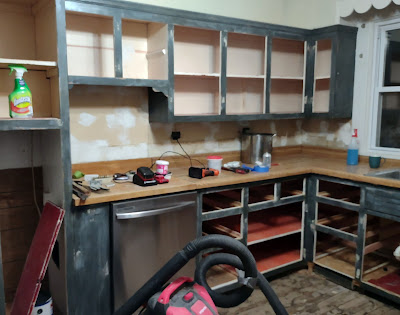Good technique means laying off the weird experiments, and pouring your creativity into the narrow area that matters—the content itself.
 |
| My current canvas. |
“Has anyone ever bought a house and not thought the previous owner was nuts?” my daughter Laura asked me. Our current home is the exception to that rule, but we bought it from friends who are meticulous. In general, she’s right.
We’re in Troy, New York, helping our third daughter work on her first house—a classic fixer-upper starter home. It was an accretion of bad style choices over solid bones and a dry basement; in other words, it was a good buy.
 |
| A 220 line and water line snaking up through an old cast-iron grate. Up to code? Possibly not. |
They’ve already removed the shag carpeting, hideous wallpaper, paneling, and five layers of flooring in the kitchen, including ceramic tile that someone nailed hardwood over. (I wouldn’t have believed it was possible.) But they stopped cold when they discovered that the stove’s 220 power line and the refrigerator’s water line both snaked through an old cast-iron heating grate in the kitchen, which was then covered with all those layers of flooring. My husband spent yesterday sorting that mess out.
Artists have an affinity for these quixotic projects. Yes, it’s cheaper to do it ourselves, but the same impulse that makes us create works on canvas also propels us into building projects. I love nothing more than a project that involves a brad nailer, miter saw, clamps, and a lot of swearing.
 |
| My son-in-law spent hours yesterday trimming these drawers to accept new faces. |
My part in this kitchen project is cosmetic. I’ve spent two days sanding and prepping the cabinet frames. Today, if all goes well, I’ll spray everything with primer. Mind you, I’ve never used an airless sprayer in my life.
“I admire that our kids are not afraid to try new things,” my husband said. I reminded him that we were building our first house at their age. “And we did lots of things flat-out wrong,” he countered. For example, we backfilled the foundation with crusher-run gravel and then had to dig it back out, laboriously, by hand. DIY is always a learn-as-you-go proposition.
My parents helped up with those building projects thirty-five years ago, and we’re helping our kids. I guess you could say we’re paying it forward.
“I think of my dad every time I do this stuff,” my wise student Mark Gale said. “Your kids will think of you when they pass down the same knowledge thirty or forty years from now.”
 |
| The old doors appeared to have been assaulted by a wildcat which needed its claws trimmed, so new doors it is. |
My bête noire in renovation is the use of whackin’ big nails to hang trim. They make no difference in the trim while it’s in place but they create an awful mess for the renovator. I inevitably spend a lot of time filling divots in plaster and raining invective down on the heads of my predecessors. Somewhere, someone is probably saying the same things about jobs I did.
That has its parallels, of course, in painting. Practically speaking, there’s no real reason you can’t paint on cardboard—it has good tooth and it’s cheap and plentiful. But if you happen to create a masterpiece, your ideas will really annoy the archivist who must stabilize it sometime down the road.
Good technique means laying off the 2” nails and the experiments with substrates, and pouring your creativity into the narrow area that matters—the content itself.
Have a wonderful time painting, and I’ll let you know how the airless sprayer works.






